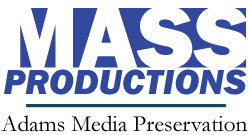Audio Cassette Transfer and Restoration to Digital
The Following is an in depth look into our careful process of Audio Cassette transfer and Restoration. Please see our Audio page for basic information about our audio transfer services.
The compact audio cassette was invented by Phillips, and first came on the market in 1962. It was intended for dictation use. However, the ease of use and portability quickly made it popular for journalists. The format was improved upon with better quality tapes, and music labels began selling pre-recorded tapes of popular albums in 1966. In 1968, Dolby B noise reduction was invented and dramatically reduced tape noise.
We have transferred thousands of cassettes, some as old as 1965. Digitizing audio cassette tapes may appear easy, but old cassettes can often suffer from a number of problems that require repairs before transfer to digital files or CD’s. Some cassettes, especially Ampex brand, will suffer from the sticky tape syndrome, and require baking to stabilize the tape for one more playback.
Sometimes the graphite lubricant inside the tape shell has dried up. This makes the tape drag, squeal, or jam. To solve this, we transplant the tape inside into new shell. Often, the felt pressure pad deteriorates into dust, or it dries up and falls out. This also requires transplanting the tape into a new shell.
The splice join between the leader and the tape dries out, and can easily come apart when the tape is rewound or played. This requires us to open the tape shell, so that we can rejoin the broken ends with a new splice.
If the tape shell does not have screws, it requires prying the cassette open. Old plastic can become very brittle, and often shatters, therefore requiring a new shell.
Calibrating the alignment of the playback tape head to the recorded tracks on the tape is very critical, as the tracks are very narrow. Tape head alignment can vary quite a bit from deck to deck, especially on portable recorders. If the playback deck is not properly matched to the original record deck alignment, the result is dull muddy sound.
We utilize very expensive Japanese audiophile cassette decks, which are the best decks ever made. These particular decks are the ONLY cassette decks with a manual tape alignment adjustment knob. Before we transfer each tape, we will adjust by ear to make sure it’s aligned so that we get optimum audio cassette transfer.
Our cassette decks have dual capstans, which dramatically reduces wow and flutter issues on sustained musical notes. Those economy tape transfer factories cannot match the quality transfers we can obtain in our studio. Besides making repairs and aligning the tape, we are very careful to set perfect audio levels in the digital transfer.
If you need to get the very best audio cassette transfer to a digital file or CD, we are experienced audio restoration experts! Please give us a call to discuss your project.
